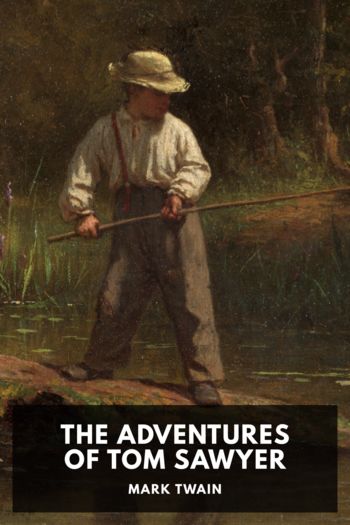Roughing It Mark Twain (e manga reader .TXT) 📖

- Author: Mark Twain
Book online «Roughing It Mark Twain (e manga reader .TXT) 📖». Author Mark Twain
The number of persons butchered by the Mormons on this occasion was one hundred and twenty.
With unheard-of temerity Judge Cradlebaugh opened his court and proceeded to make Mormondom answer for the massacre. And what a spectacle it must have been to see this grim veteran, solitary and alone in his pride and his pluck, glowering down on his Mormon jury and Mormon auditory, deriding them by turns, and by turns “breathing threatenings and slaughter!”
An editorial in the Territorial Enterprise of that day says of him and of the occasion:
“He spoke and acted with the fearlessness and resolution of a Jackson; but the jury failed to indict, or even report on the charges, while threats of violence were heard in every quarter, and an attack on the U.S. troops intimated, if he persisted in his course.
“Finding that nothing could be done with the juries, they were discharged with a scathing rebuke from the judge. And then, sitting as a committing magistrate, he commenced his task alone. He examined witnesses, made arrests in every quarter, and created a consternation in the camps of the saints greater than any they had ever witnessed before, since Mormondom was born. At last accounts terrified elders and bishops were decamping to save their necks; and developments of the most starling character were being made, implicating the highest Church dignitaries in the many murders and robberies committed upon the Gentiles during the past eight years.”
Had Harney been Governor, Cradlebaugh would have been supported in his work, and the absolute proofs adduced by him of Mormon guilt in this massacre and in a number of previous murders, would have conferred gratuitous coffins upon certain citizens, together with occasion to use them. But Cumming was the Federal Governor, and he, under a curious pretense of impartiality, sought to screen the Mormons from the demands of justice. On one occasion he even went so far as to publish his protest against the use of the U.S. troops in aid of Cradlebaugh’s proceedings.
Mrs. C. V. Waite closes her interesting detail of the great massacre with the following remark and accompanying summary of the testimony—and the summary is concise, accurate and reliable:
“For the benefit of those who may still be disposed to doubt the guilt of Young and his Mormons in this transaction, the testimony is here collated and circumstances given which go not merely to implicate but to fasten conviction upon them by ‘confirmations strong as proofs of Holy Writ:’
“1. The evidence of Mormons themselves, engaged in the affair, as shown by the statements of Judge Cradlebaugh and Deputy U.S. Marshall Rodgers.
“2. The failure of Brigham Young to embody any account of it in his Report as Superintendent of Indian Affairs. Also his failure to make any allusion to it whatever from the pulpit, until several years after the occurrence.
“3. The flight to the mountains of men high in authority in the Mormon Church and State, when this affair was brought to the ordeal of a judicial investigation.
“4. The failure of the Deseret News, the Church organ, and the only paper then published in the Territory, to notice the massacre until several months afterward, and then only to deny that Mormons were engaged in it.
“5. The testimony of the children saved from the massacre.
“6. The children and the property of the emigrants found in possession of the Mormons, and that possession traced back to the very day after the massacre.
“7. The statements of Indians in the neighborhood of the scene of the massacre: these statements are shown, not only by Cradlebaugh and Rodgers, but by a number of military officers, and by J. Forney, who was, in 1859, Superintendent of Indian Affairs for the Territory. To all these were such statements freely and frequently made by the Indians.
“8. The testimony of R. P. Campbell, Capt. 2nd Dragoons, who was sent in the Spring of 1859 to Santa Clara, to protect travelers on the road to California and to inquire into Indian depredations.”
Appendix C Concerning a Frightful Assassination That Was Never Consummated[If ever there was a harmless man, it is Conrad Wiegand, of Gold Hill, Nevada. If ever there was a gentle spirit that thought itself unfired gunpowder and latent ruin, it is Conrad Wiegand. If ever there was an oyster that fancied itself a whale; or a jack-o’lantern, confined to a swamp, that fancied itself a planet with a billion-mile orbit; or a summer zephyr that deemed itself a hurricane, it is Conrad Wiegand. Therefore, what wonder is it that when he says a thing, he thinks the world listens; that when he does a thing the world stands still to look; and that when he suffers, there is a convulsion of nature? When I met Conrad, he was “Superintendent of the Gold Hill Assay Office”—and he was not only its Superintendent, but its entire force. And he was a street preacher, too, with a mongrel religion of his own invention, whereby he expected to regenerate the universe. This was years ago. Here latterly he has entered journalism; and his journalism is what it might be expected to be: colossal to ear, but pigmy to the eye. It is extravagant grandiloquence confined to a newspaper about the size of a double letter sheet. He doubtless edits, sets the type, and prints his paper, all alone; but he delights to speak of the concern as if it occupies a block and employs a thousand men.
[Something less than two years ago, Conrad assailed several people mercilessly in his little People’s Tribune, and got himself into trouble. Straightway he airs





Comments (0)